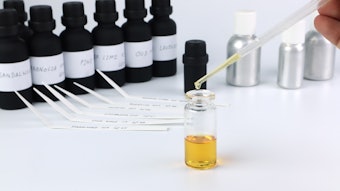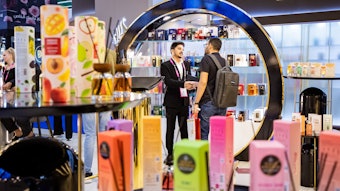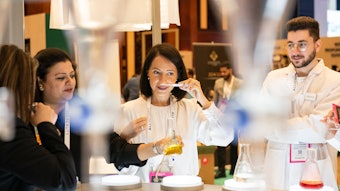Brownell talks about vanilla and fair trade in our March vanilla-focus issue.
Vanilla 2007, organized by Daphna Havkin-Frenkel (Bakto Flavors), took place November 7th and 8th at the Forsgate Country Club in Jamesburg, NJ. More than 80 international attendees gathered to share the latest information on commercial and scientific developments in vanilla.
What is Natural Vanillin?
Day two of the Congress provided more surprises and controversial presentations. Betsy Carlton of Rhodia gave a presentation on the company’s Rhovanil vanillin. Carlton explained that Rhovanil vanillin is produced from rice husks using a fermentation process. The FDA has previously stated on many occasions that vanillin can only be considered natural if it is derived from vanilla beans. After several meetings, in which Rhodia demonstrated that the process itself is natural, the FDA consented to let Rhodia market Rhovanil as “vanillin derived naturally through fermentation.”
Carleton explained that Rhodia’s interpretation of the FDA’s statement means that Rhovanil can be used as natural flavor in any food or beverage. This would seem to contradict previous FDA statements including a letter in 2005 from Catalina Frerre-Hockensmith, consumer safety officer at the Division of Food Labeling and Standards, which said, “Although we would not object to a statement on the label indicating that vanillin is derived naturally through a fermentation process, we point out that such a statement should not imply that the vanillin is a natural flavor or that a finished food containing it is natural.”
Carlton and her colleagues diffused the controversy to some extent by acknowledging that the cost ($1,400/kg) and limited availability of Rhovanil meant that its impact on the natural vanilla market was likely to be minimal. A number of attendees expressed an interest in seeking further clarification from the FDA, and this is likely to be subject of debate for some time to come. As an aside, researchers from Japan reported in 2006 that they had synthesized vanillin from cow manure. No word on whether they to have applied to the FDA for natural status.
Chemistry and Physics of Vanilla
Later in the morning, Chaim Frenkel, professor of plant pathology at Rutgers University, presented research on the chemistry and physics of vanillin. Frenkel discussed the impact of temperature, humidity, pH, microbes and enzymes on the development and retention of vanillin and other chemical compounds critical to the flavor and aroma of vanilla beans and extracts. He explained that these factors may have implications for the curing and storage of vanilla beans. Frenkel concluded that there is much still to be learned from this area of research.
Origins of Tahitian Vanilla
Pesach Lubinsky, a graduate student at the University of California, discussed the origins of the species Vanilla tahitiensis. Working in collaboration with Kenneth Cameron of the New York Botanical Gardens, Lubinsky revealed that the origins of vanilla date back at least 65 million years, before the earth’s continents had separated. This helps explain why Vanilla is so widely dispersed throughout the tropical regions of the world. Lubinsky enthusiastically recounted his visit to Tahiti as one of the highlights of his research. More seriously, he reported that the evidence is now conclusive that V. tahitiensis is itself, in fact, a natural hybrid of Vanilla planifolia and Vanilla odorata. Vanilla odorata is so named because it is one of the few known vanilla orchids that have a discernable scent. Finally, Lubinsky explained that scientific analysis confirms the legend of Hernan Cortez as the “Johnny Appleseed” of vanilla. The Papantla region of Mexico is indeed the source of all vanilla grown in Madagascar, Indonesia and the other major producing countries, excluding Tahiti and Papua New Guinea.
Fingerprinting Vanilla
In the afternoon session, Tom Hartman, manager of the CAFT Mass Spectrometry Facility and research professor in food science at Rutgers University, gave an update on his ongoing research into the chemical composition of vanilla beans. Hartman has developed a unique extraction process called direct thermal desorption (DTD), which enables him to isolate chemical compounds in vanilla beans that are lost in traditional extraction processes. Using GC/MS analysis, Hartman has been able to identify more than 200 individual compounds present in vanilla beans. Hartman has extended his work to provide new methods for detecting adulteration of vanilla beans and fingerprinting beans from different geographical origins.
Reviving Tahitian Vanilla
Francois-Xavier Collard discussed new agricultural and curing technologies in Tahiti. Once a major producer of vanilla beans, production in Tahiti has fallen over the last few decades to less than 10 metric tons per year. Now, a new initiative growing vanilla in net shade houses provides hope that Tahitian vanilla output will increase significantly in coming years. The initial capital cost of the shade house is shared by the farmer (40%) and the Tahitian government (60%). The shade houses provide better control of cultivation conditions and improved working conditions over traditional growing methods. Collard also discussed the unique aromatic profile of Tahitian vanilla beans. Some of this can be attributed to the species itself, Vanilla tahitiensis. However, he also cited the fact that Tahitian vanilla is not harvested until full maturity. In a very interesting set of slides, he showed that Tahitian vanilla virtually begins to cure on the vine, as evidenced by the rapid change in color from green to yellow to chocolate brown. By contrast, vanilla in other countries is typically considered mature and picked at the first signs of yellowing of the tip.
The Future of Natural Vanillin
Finally, Daphna Havkin-Frenkel of Rutgers University gave a presentation on the biotechnology production of vanillin from herbs using microorganisms. Havkin-Frenkel explained that vanillin exists in many herbs and plant materials. Biosynthesis of vanillin using microorganisms and other means is not new, and she predicted that the FDA’s ruling on Rhodia’s Rhovanil will likely encourage a host of other companies to submit similar products for approval.
Additional presentations on day two included:
- “Recent Developments in Extraction Technology” by Paul Takhistov of Rutgers University.
- “Different Forms of Vanilla and Their Uses” by Dolf De Rivera of Flavor Dynamics.
- “The Use of Vanilla in Perfumes” by Felix Buccellato of Custom Essence.
- “Lipids from Vanilla Beans” by Michael Blumenthal of Libra Technical Center.
Vanilla 2007 provided many new insights into the science and commercialization of vanilla. It provided a forum for many people in the vanilla industry to exchange ideas and meet others with a common interest in the world’s most popular flavor. Further information on the conference and the individual presentations can be found at the official Web site here.










